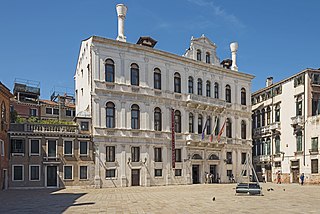
The Grand Canal is the largest channel in Venice, Italy, forming one of the major water-traffic corridors in the city.

Ca' Foscari, the palace of the Foscari family, is a Gothic building on the waterfront of the Grand Canal in the Dorsoduro sestiere of Venice, Italy.

The Fondaco dei Tedeschi is a historic building in Venice, northern Italy, situated on the Grand Canal near the Rialto Bridge. It was the headquarters and restricted living quarters of the city's German (Tedeschi) merchants.

The Palazzo Giustinian is a palace in Venice, northern Italy, situated in the Dorsoduro district and overlooking the Grand Canal next to Ca' Foscari. It is among the best examples of the late Venetian Gothic and was the final residence of Princess Louise of Artois.

Palazzo Loredan dell'Ambasciatore is a late 15th-century Gothic palace in Venice, Italy, that once belonged to the noble Loredan family. Located in the Dorsoduro sestiere (quarter), it was called "dell'Ambasciatore" because it was offered as a home of the ambassadors of the Austrian Empire to the Republic by Doge Francesco Loredan.

Palazzo Balbi is a palace on the Canal Grande, Venice, northern Italy. It is included in the sestiere (quarter) of Dorsoduro, to the right of Ca' Foscari. Currently it is the seat of the President of the Veneto region and of the regional council.

Palazzo Belloni Battagia is a palace on the Canal Grande, Venice, northern Italy. It is located in the sestiere (district) of Santa Croce, between the Fondaco del Megio and Ca' Tron, near the church of San Stae.

The Fondaco del Megio is a palace in the sestiere (quarter]) of Santa Croce in Venice, northern Italy. Located near the Palazzo Belloni Battagia and the Fondaco dei Turchi, it faces the Canal Grande and is opposed to the church of San Marcuola of Cannaregio.

Ca' Tron is a palace in Venice, northern Italy, facing the Canal Grande. Part of the sestiere (quarter) of Santa Croce, it is situated between the Palazzo Belloni Battagia and Palazzo Duodo, near the church of San Stae. It is owned by the Università Iuav di Venezia and houses the Department of Design and Planning in Complex Environments.

Ca' Farsetti is a palace in Venice, Italy. It is located in the sestiere (district) of San Marco, and faces the Grand Canal, not far from the Ponte di Rialto. The neighboring building is Palazzo Cavalli.

Palazzo Corner della Ca' Granda, also called Ca' Corner della Ca' Granda or simply Palazzo Corner or Palazzo Cornaro, is a Renaissance-style palace located between the Casina delle Rose and the Rio di San Maurizio (Venice), across the Grand Canal from the Palazzo Venier dei Leoni, in the city of Venice, Italy. It is the current seat of the province of Venice and of the city's prefect.

The Palazzo Papadopoli is a Baroque-style palace located on the Canal Grande of Venice, between Palazzo Giustinian Businello and Palazzo Donà a Sant'Aponal in the Sestiere of San Polo, Venice, Italy. The opposite building is the Palazzo Corner Contarini dei Cavalli.

Palazzo Correr Contarini Zorzi is a Renaissance palace in Venice, Italy, overlooking the Grand Canal and locating in the Cannaregio district between Palazzo Querini Papozze and Palazzo Gritti. The palazzo is also known as Ca' dei Cuori, a family whose wrought iron coats of arms is present on the façade.

Palazzo Gritti is a palace in Venice, Italy, located in the Cannaregio district and overlooking the Grand Canal between Palazzo Memmo Martinengo Mandelli and Palazzo Correr Contarini Zorzi.

Palazzo Giustinian Loredana S. Stin is a 16th-century palace of the Loredan family located in the San Polo district of Venice.

Palazzo Priuli Ruzzini Loredan, also called Palazzo Loredan at Campo Santa Maria Formosa, is a late 16th-century palace located at Campo Santa Maria Formosa in the Castello district of Venice, northern Italy, characterised by features of Renaissance and Baroque-style architecture on its façades.

Palazzo Moro Lin, also known as Palazzo Morolin Michiel Olivo, is a Venetian palace located in the San Polo sestiere.

Palazzo Mocenigo Gambara is a palace in Venice, located in the Dorsoduro district and overlooking the Grand Canal, between the Contarini Palazzi degli Scrigni and Corfù and Palazzo Querini alla Carità, not far from the Gallerie dell'Accademia and in front of Palazzo Giustinian Lolin.

Palazzo Corner Contarini dei Cavalli is a palace in Venice, located in the San Marco district, overlooking the left side of the Grand Canal, between the Rio di San Luca and Palazzo Grimani di San Luca on one side and Palazzo Tron and Palazzetto Tron Memmo on the other. The opposite structure is the Palazzo Papadopoli.

Palazzo Cavalli or Palazzo Corner Martinengo is a palace in Venice, located in the San Marco district and overlooking the Grand Canal. It locates not far from the Ponte di Rialto, between Palazzo Corner Valmarana and Ca' Farsetti, in front of Palazzo Barzizza.






















